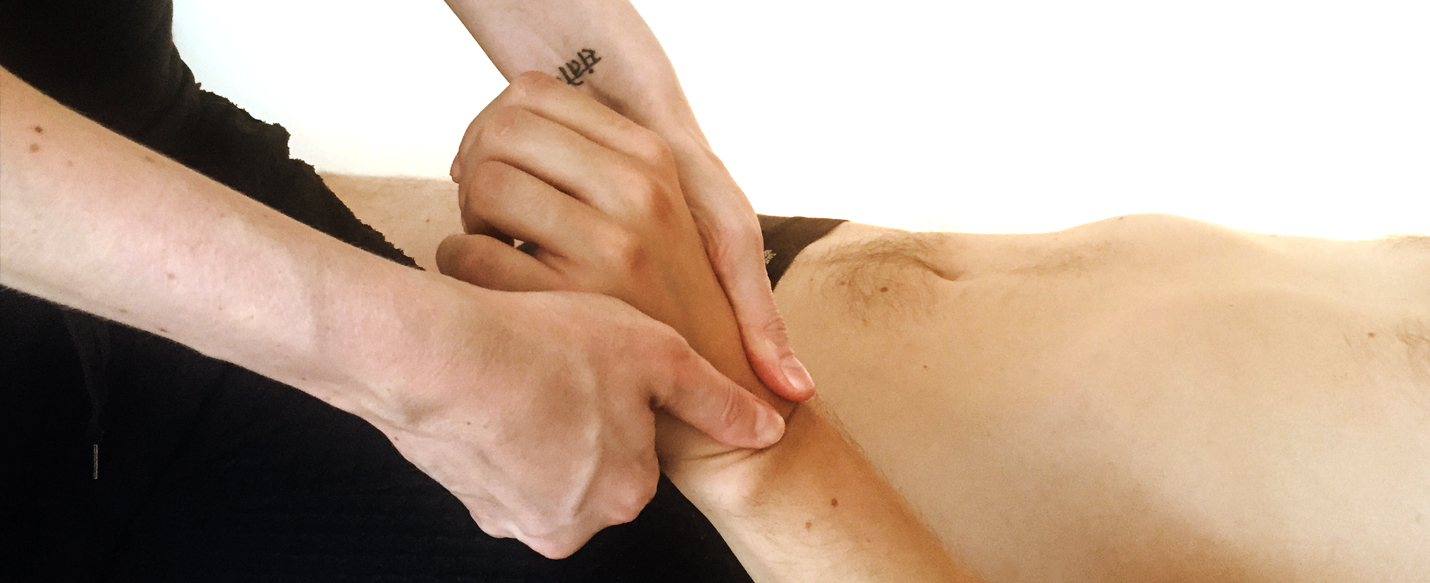What is fascia and what is its influence on the body?
Fascia is the connective tissue that envelops, supports and separates all muscles, bones, nerves and organs. It weaves through our body in a complex, web-like fashion, holding all body parts in their place while at the same time allowing for the connection to different, more distant body parts. It mostly consists of collagen fibres, which makes it very flexible and resilient.
Due to different forces, such as bad postural habits, repetitive motions or injuries, fascia can become less flexible, shorter and/or thicker in certain parts of the body. This can lead to discomforts or pain directly in the affected area. Often, however, this shortening or thickening of connective tissue in one part of the body leads to discomfort or pain in a more distant area of the body. This is because the affected fascia pulls another area out of place, which in turn leads to an imbalance in the body. This is a very common phenomenon in lower back pain, for example.
Through the systematic manipulation of fascia, Rolfing® can help loosen and redirect the connective tissue, restoring its flexibility and resilience. Consequently, imbalances in the body are reduced and symptoms can be alleviated. By working in this holistic way, Rolfing® can help clients find longer-lasting alleviation of discomfort or pain and a greater sense of overall wellbeing.
Is Rolfing® right for me?
Rolfing® is for people of all ages and all walks of life. Different clients come to Rolfing® for different reasons. Many initially come because of physical pain or discomforts that arise due to injuries, bad postural habits from sitting or standing and/or activities that include repetitive motions or unilateral use of the body. Rolfing® can help alleviate many common discomforts and aches such as back, neck, shoulder, hip and knee pain, as well as stress related pain such as tension in the neck and headaches/migraines.
Rolfing® can also help improve performance in sports, dance or music. It can also be beneficial for women after pregnancy, those who want to improve their range of motion or posture, and those that just want to maintain their overall health. When the body is well aligned and gravity can flow through easily, it can perform in more economical and effortless ways.
How many Rolfing® sessions do I need?
This mostly depends on your individual goals. Traditionally, Rolfing® is built on a series of ten sessions that aim at systematically (re-) aligning and balancing the body in a holistic way. Therefore, the greatest benefits can be felt when receiving the ten sessions. Still, many clients report small to significant changes and improvements in their physical wellbeing after only one to three sessions.
Does Rolfing® hurt?
Rolfing® should not hurt. You might feel discomfort when the Rolfer™ works on body parts that are tight. Still, you should always be able to breathe comfortably. I check with my clients on a regular basis how they are feeling and encourage them to tell me when they feel pain or any other discomfort.
What happens during a session?
Sessions normally begin with a visual analysis of the body in standing and walking. This way, the Rolfer™ can analyse your body structure, posture and movement patterns and identify the goals for each session.
Most work on your body is performed on the table. The Rolfer™ might ask you to change positions and also to perform certain movements. Some work, mostly towards the end of the session, might also be done in sitting or standing. Movement education is often included, either during and/or at the end of a session.
At the end of the session, the Rolfer® normally asks you to stand and walk once more so you can feel the effects of the work. It also helps the Rolfer® to make a quick analysis in advance of the following session.
How long is a regular session?
Sessions may vary in length. This is because each session has a different focus. On average, a session takes 70 minutes, including preparation and post-processing.
How often should I have sessions?
It is best to have sessions in intervals of every 2 to 4 weeks. In the beginning of the treatment, many clients prefer to have a session every week, which is also fine. However, I do not advise to have sessions more than once a week, as the body would most probably not have enough time to integrate the work of the previous session.
What do I wear?
It is best for the Rolfer® to work directly on the skin. This way, it is easier to feel and work on the different layers of connective tissue (fascia). Therefore, clients normally wear their regular underwear. Alternatively, a bikini or short swimming trunks, as well as gym shorts and sports bras can be worn. While working on the table, we can use a sheet or a blanket so you feel more comfortable and warm.
How much does it cost?
Please refer to the rates page for details on prices.
Does my health insurance cover the costs for treatment?
Rolfing® Structural Integration is recognised in Switzerland as an alternative treatment method. Most Swiss health insurances, via their complementary insurance models, take on part of the cost of the treatment. Please check with your health insurance provider about the details prior to the first session. I am EMR-, ASCA- and EGK certified and therefore recognised by most health insurances. My ZSR number is S640063.
I have more questions…
I am happy to answer any other questions you might have about Rolfing® and the sessions via email or phone.
